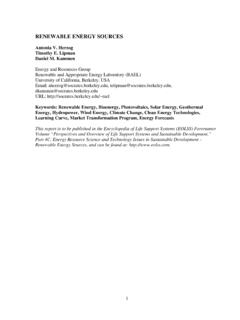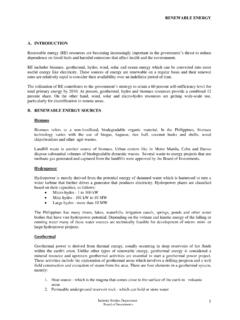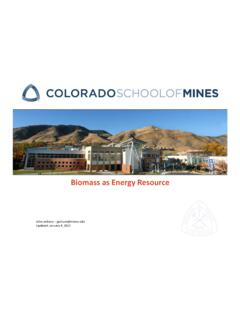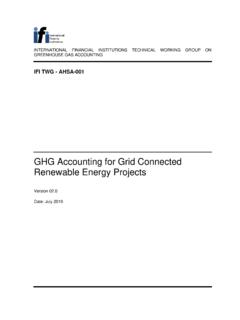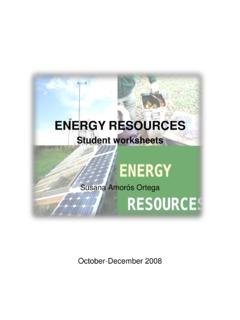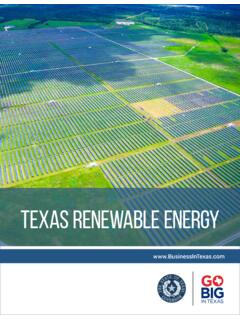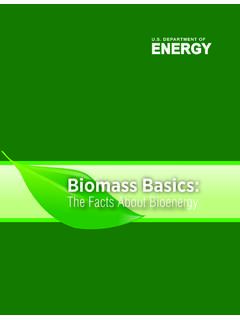Transcription of Renewable Energy: An Overview. Energy Efficiency and ...
1 DOE/GO-102001-1102. FS175. Energy March 2001. Efficiency . AND. Renewable Energy : Renewable An Overview CLEARINGHOUSE. Energy What is Renewable Energy ? safety concerns and waste disposal prob- lems, the United States will retire much of Renewable Energy uses Energy sources its nuclear capacity by 2020. In the mean- that are continually replenished by time, the nation's Energy needs are nature the sun, the wind, water, the expected to grow by 33 percent during the Earth's heat, and plants. Renewable next 20 years. Renewable Energy can help Energy technologies turn these fuels into fill the gap. usable forms of Energy most often elec- tricity, but also heat, chemicals, or Even if we had an unlimited supply of fos- mechanical power. sil fuels, using Renewable Energy is better for the environment. We often call renew- Why Use Renewable Energy ? able Energy technologies clean or Today we primarily use fossil fuels to heat green because they produce few if any and power our homes and fuel our cars.
2 Pollutants. Burning fossil fuels, however, It's convenient to use coal, oil, and natural sends greenhouse gases into the atmos- gas for meeting our Energy needs, but we phere, trapping the sun's heat and con- have a limited supply of these fuels on the tributing to global warming. Climate Earth. We're using them much more scientists generally agree that the Earth's rapidly than they are being created. Even- average temperature has risen in the past tually, they will run out. And because of century. If this trend continues, sea levels will rise, and scientists predict that floods, heat waves, droughts, and other extreme weather conditions could occur more often. Other pollutants are released into the air, soil, and water when fossil fuels are burned. These pollutants take a dramatic toll on the National Park Service, NREL/PIX04924. environment and on humans.
3 Air pollution contributes to diseases like asthma. Acid rain from sulfur dioxide and nitrogen oxides harms plants and fish. Nitrogen oxides also contribute to smog. A PV-system at the Pinnacles National Monument in California eliminates a $20,000 annual fuel bill for a diesel generator that pro- duced each year 143 tons of carbon dioxide a greenhouse gas. NT OF. ME EN. RT. This document was produced for the Department of Energy (DOE) by the National Renewable Energy Laboratory (NREL), a DOE national laboratory. The A. ER. DEP. GY. document was produced by the Information and Outreach Program at NREL for the DOE Office of Energy Efficiency and Renewable Energy . The Energy Efficiency I CA. U N IT. and Renewable Energy Clearinghouse (EREC) is operated by NCI Information Systems, Inc., for NREL / DOE. The statements contained herein are based on information known to EREC and NREL at the time of printing.
4 No recommendation or endorsement of any product or service is implied if mentioned by EREC. ER. ED. M. ST A. AT E S OF. Printed with a Renewable -source ink on paper containing at least 50% wastepaper, including 20% postconsumer waste Renewable Energy will also help us Bioenergy develop Energy independence and secu- rity. The United States imports more than Bioenergy is the Energy derived from bio- 50 percent of its oil, up from 34 percent in mass (organic matter), such as plants. If 1973. Replacing some of our petroleum you've ever burned wood in a fireplace or with fuels made from plant matter, for campfire, you've used bioenergy. But we example, could save money and don't get all of our biomass resources strengthen our Energy security. directly from trees or other plants. Many industries, such as those involved in con- Renewable Energy is plentiful, and the struction or the processing of agricultural Hydropower is our technologies are improving all the time.
5 Products, can create large quantities of There are many ways to use Renewable unused or residual biomass , which can most mature and Energy . Most of us already use Renewable serve as a bioenergy source. Energy in our daily lives. largest source of Biopower Hydropower After hydropower, biomass is this coun- Renewable power try's second-leading resource of Renewable Hydropower is our most mature and Energy , accounting for more than 7,000. largest source of Renewable power, pro- MW of installed capacity. Some utilities ducing about 10 percent of the nation's and power generating companies with electricity. Existing hydropower capacity coal power plants have found that replac- is about 77,000 megawatts (MW). Hydro- ing some coal with biomass is a low-cost power plants convert the Energy in flowing option to reduce undesirable emissions. water into electricity.
6 The most common As much as 15 percent of the coal may be form of hydropower uses a dam on a river replaced with biomass . biomass has less to retain a large reservoir of water. Water is sulfur than coal. Therefore, less sulfur released through turbines to generate dioxide, which contributes to acid rain, is power. Run of the river systems, how- released into the air. Additionally, using ever, divert water from the river and biomass in these boilers reduces nitrous direct it through a pipeline to a turbine. oxide emissions. Hydropower plants produce no air emis- A process called gasification the conver- sions but can affect water quality and sion of biomass into gas, which is burned wildlife habitats. Therefore, hydropower in a gas turbine is another way to gener- plants are now being designed and oper- ate electricity. The decay of biomass in ated to minimize impacts on the river.
7 Landfills also produces gas, mostly Some of them are diverting a portion of methane, which can be burned in a boiler the flow around their dams to mimic the to produce steam for electricity generation natural flow of the river. But while this or industrial processes. biomass can also improves the be heated in the absence of oxygen to wildlife's river chemically convert it into a type of fuel oil, habitat, it also called pyrolysis oil. Pyrolysis oil can be reduces the power used for power generation and as a feed- plant's output. In stock for fuels and chemical production. addition, fish lad- ders and other Biofuels approaches, such biomass can be converted directly into liq- as improved tur- uid fuels, called biofuels. Because biofuels bines, are being Duane Hippe, NREL/PIX04410. are easy to transport and possess high used to assist fish Energy density, they are favored to fuel with migration vehicles and sometimes stationary power and lower the generation.
8 The most common biofuel is number of fish ethanol, an alcohol made from the fermen- killed. tation of biomass high in carbohydrates. The current largest source of ethanol is corn. A small-scale hydropower system in King Cove, Some cities use ethanol as a gasoline addi- Alaska, provides residents in this remote area with a less expensive source of electricity. tive to help meet air quality standards for 2. ozone. Flex-fuel amounts to 50,000 times the Energy of all vehicles are also oil and gas resources in the world. In the now on the market, United States, most geothermal reservoirs which can use a are located in the western states, Alaska, mixture of gasoline and Hawaii. GHPs, however, can be used and ethanol, such almost anywhere. as E85 a mixture of 85 percent Geothermal Electricity Production Warren Gretz, NREL/PIX04744. ethanol and 15 per- Geothermal power plants access the under- cent gasoline.
9 Ground steam or hot water from wells Another biofuel is drilled a mile or more into the earth. The biodiesel, which steam or hot water is piped up from the can be made from well to drive a conventional steam turbine, vegetable and ani- which powers an electric generator. Typi- This gasifier in Burlinton, Vermont, converts biomass mal fats. Biodiesel cally, the water is then returned to the into a clean gas for electricity production can be used to fuel ground to recharge the reservoir and com- a vehicle or as a plete the Renewable Energy cycle. fuel additive to reduce emissions. There are three types of geothermal power Corn ethanol and biodiesel provide about plants: dry steam, flash steam, and binary percent of the total liquid fuels market. cycle. Dry steam plants draw from reser- To increase our available supply of biofu- voirs of steam, while both flash steam and els, researchers are testing crop residues binary cycle plants draw from reservoirs such as cornstalks and leaves wood of hot water.
10 Flash steam plants typically chips, food waste, grass, and even trash as use water at temperatures greater than potential biofuel sources. 360 F. Unlike both steam and flash plants, binary-cycle plants transfer heat from the Biobased Products water to what's called a working fluid. If you've ever burned biomass corn, wheat, soybeans, wood, Therefore binary cycle plants can operate and residues can also be used to produce using water at lower temperatures of wood in a fireplace chemicals and materials that we normally about 225 to 360 F. obtain from petroleum. Industry has or campfire, you've already begun to use cornstarch to pro- duce commodity plastics, such as used bioenergy. shrinkwrap, plastic eating utensils, and Joel Renner, INEEL, NREL/PIX07658. even car bumpers. Commercial develop- ment is underway to make thermoset plastics, like electrical switch plate covers, from wood residues.










